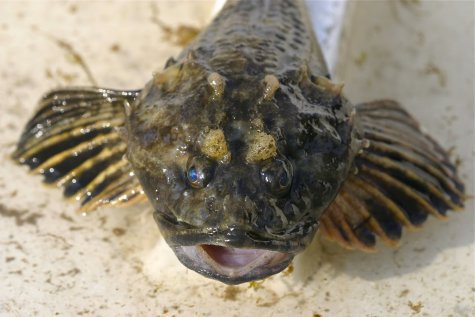Winter spawners
Photo: Tiit Hunt
Translation: Liis
Four-horn sculpin Merihärg Triglopsis quadricornis
Fish living in the depths of the sea maybe don’t often come to mind except when you happen to notice a fish with roe running out among the catch. The roe of the fourhorn sculpin is dark, bluish-green, with only slightly smaller grain size than trout roe. Quite edible by the way – fish roe as ever was.
The fourhorn sculpin inhabits the Baltic as a relict from the Ice Age, hence also the archaic exterior; it belongs to the Cottidae or sculpin family, and related species, similar to confusion, are the shorthorn sculpin and the longspined bullhead – amusing names. Length largely up to thirty centimetre; on the flat head of the fourhorn sculpin we note four spongy bone protuberances. Its skin is not covered by scales but on the sides and back of the fish there are rows of little bone patches that appear as lighter spots.
It lives along almost all of the Estonian coast since the salinity of the water is not very important for its life processes although it still remains a marine species. Based on literature data the spawning might start already in the second half of December; the spawning takes place in areas rather close to the shore and covered with gravel, sand or also rocks.
We must talk about the life arrangements of the four-horn sculpin in the spawning period and immediately afterwards. The female fish spawns on the sea bottom, the male fish fertilizes the roe with milt – all as usual. Only the male sculpin stays to monitor the development of the roe, protecting the future sea inhabitant against any imaginable dangers and enemies. Depending on many factors this can last up to three months and the “selflessness” shows in the fact that the guardian during this time will not even take the time to move away from the nest to feed. If it is disturbed the sculpin makes a characteristic low, growling, vibrating sound. Seashore fishermen can attest to having heard it.









